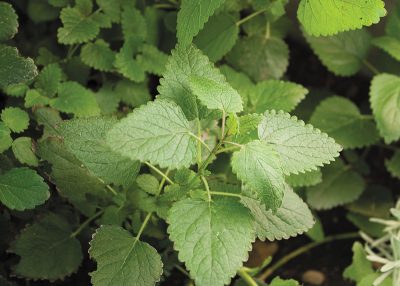
Eaux of Olde: Waterpocket’s Eau de Mélisse
Food: Interviews & Features
2084 W 2200 S, West Valley City, UT
Monday–Wednesday 11:00a.m.–5:00p.m.
Saturday 11:00a.m.–6:00p.m.
385.202.5725 | waterpocket.co
In their Long Lost line of spirits, Waterpocket Distillery crafts the Oread liqueur. It’s a previously forgotten Danziger spirit that the local distillery revived, and for which SLUG recognized them at our spring Brewstillery on May 12, 2018 (taking place again this fall at the Union Event Center on Nov. 17). Waterpocket continues with these kind of modern-craft iterations of rare spirits, most recently with the Eau de Mélisse. Waterpocket Co-Owner Alan Scott traces the steps of undergoing such a revival process for a historically based spirit with the Eau de Mélisse.
On paper, Eau de Mélisse was interesting for many reasons. It was once well-known, but had largely disappeared as a beverage. At some point, one part of the tradition morphed into a perfume or a topical ointment. One of our colleagues, who is originally from Germany, immediately recognized the name and indicated that she knew it as something like a liniment. If you Google Eau de Mélisse, that’s probably what you’ll find first (but go to the Eau de Mélisse des Carmes in French Wikipedia for a fuller history). Most of our sources showed that it was a distilled spirit—alongside other beverage spirits. Our curiosity was stoked.
We distilled our first small batch of Eau de Mélisse in the late summer of 2017. We bottled it a several months later, eventually waiting on TTB approvals and testing prior to release in the summer of 2018. The distillation was the culmination of a long process of the research, lab testing (and lab failures!), and a serendipitous set of circumstances around the time we made the batch. Like some of our other products, like Oread, the original impulse was to take a historical spirit—very rare or unknown in the U.S. or Utah—and use our stills to bring it to life.

There are numerous references to Eau de Mélisse in the historical works we’ve researched. It was known far and wide as a staple product (in the 19th century and earlier). It is usually referred to as Eau De Mélisse des Carmes, paying homage to its origins and pedigree as a medicinal elixir produced in the Carmelite convents of France. Long were the formulas kept secret. As imitations appeared, attempts were made to patent the formulas to protect the revenue associated with it—which, by then, was critical to the convents that its manufacture supported. Eventually, a licensing arrangement guaranteed income to the convents, but the formulas escaped their control and were eventually published in the early 1700s. This period saw many traditional elixirs escape the walls of the cloister and emerge in Western culture as more cultivated and aesthetically driven beverages (e.g., Chartreuse, absinthe, amaros and many other botanical spirits).
Mélisse means “lemon balm” in French, and it’s a member of the Lamiaceae or mint family (which also includes basil, rosemary, sage, marjoram, oregano, hyssop and thyme). Eau de Mélisse is unique in its use of fresh herbs—as many of the herbs should be fresh and in flower as possible. We found the lemon balm and the hyssop fresh. Hyssop is another minty plant with a slight bitter taste used to flavor wines since Roman times. Like lemon balm, beekeepers love it for producing aromatic honeys.
The rest of the ingredients we have in varying amounts from the production or testing of other spirits. When the lemon balm fell into our hands, we went for it. We peeled many pounds of actual lemons, cleared the garden of our sage and rosemary plants, supplemented elsewhere with dried herbs, and used the last stock of true cinnamon we possessed. The last-minute addition of mugwort (artemisia vulgaris, a relative of wormwood) cost us about two months with the TTB, as we subsequently needed to have the distillate tested for thujone, an alkaloid with a bad reputation from the absinthe-prohibition days, and we easily passed their test. We packed the still with botanicals and pure, neutral alcohol, macerated then distilled.
As the first distillate left the condenser, we knew that we were on to something. Here was a spirit both bold and soft, sitting at a harmonious intersection of lemon citrus and herbal with accents of warm spice. It’s hard to describe, but this spirit had a “roundness,” which we assume is imparted from the dominance of the lemon balm—but this dominance doesn’t crowd out the accent flavors. Another immediate revelation: This spirit could ultimately be as flexible and amenable to a wide variety of presentations as gin. Instead of the juniper anchor, lemon balm could provide the flexible cornerstone against which a spectrum of botanicals could play.
Outside of the distillery in the cocktail space, we’ve found the versatility of the spirit as a substitute for gin. Master mixologist Adam Bagby of Post Office Place used it to work up mélisse-based suite of gin-alternative cocktails including the martini, negroni and the French 75. But we think its potential in the cocktail space is only beginning.
Technical details: Alcohol 44.4% / 88.8 proof. Base spirit: highly refined, gluten-free wheat grain neutral spirit. In pot maceration on Waterpocket’s “Warlock” carter-head style, Aromat-equipped 230-liter still (manufactured by Muller in Germany). –Alan Scott

French 75 with Waterpocket Eau de Mélisse
1 oz. Eau de Mélisse
1/2 oz. fresh lemon juice
1/2 oz. simple syrup
Top with sparkling wine
– Shake all ingredients except for sparkling wine in a cocktail shaker.
– Strain into a cocktail glass and top with sparkling wine. Garnish with lemon zest.
Cocktail designed by Adam Bagby.